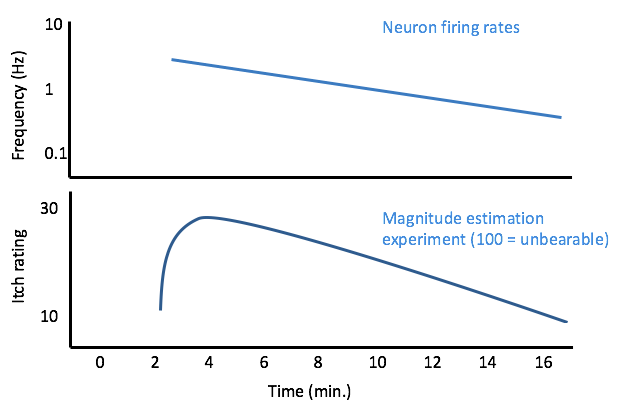Somatosensation
16 Itch
Learning Objectives
Know how neurons initiate a sensation of itching.
Be able to describe an experiment that tests whether or not itch is a sensation other than pain.
Itch was not originally identified as its own sensory modality. Instead, researchers thought itch was the brain’s interpretation (perception) of mild or subthreshold stimulation of nociceptors. However, specific receptors for itch have been identified, which means that itch is a unique sensation. For example, capsaicin activates receptors on peripheral nerve endings to induce pain, while histamine activates different receptors on a subset of capsaicin-responsive nerve endings to induce itch (LaMotte, 2014).
Unique, itch-selective neurons have been discovered and characterized as having unmyelinated axons with free nerve endings, not unlike thermal and mechanical nociceptors. In a microneurography experiment, researchers isolated the unmyelinated axons of 56 different neurons in the legs of healthy volunteers (Schmelz, 1997). None of the axons carried spontaneous action potentials, and 13 did not respond to high heat or strong pressure, ruling them out as mechanoreceptors or thermal nociceptors. However, when histamine was slowly injected into the skin, the neurons that had been non-responsive started sending action potentials. The rate of action potentials correlated with the participants’ reports of the severity of the itch, and when the action potentials started fading away, so did the sensation of itch (see Fig.2.7.1).

It is still unknown exactly how itch signals are coded separately from pain signals in the central nervous system. It is widely accepted that there does not exist a labeled line for itch, as itch-responsive neurons are a subset of pain-responsive neurons in the spinal cord and cortex. Instead, it is likely that itch is mediated by a population code whereby specific activation of itch-selective neurons within the population of pain-responsive neurons results in the perception of itch (LaMotte, 2014).

Provided by: University of Minnesota
License: CC BY 4.0
References:
Schmelz et al (1997). Specific C-Receptors for Itch in Human Skin. J. Neuroscience 17(20):8003-8008
LaMotte, Dong, and Ringkamp (2014). Sensory neurons and circuits mediating itch. Nature Reviews: Neuroscience. 15: 19-31.
Lamotte, Robert & Dong, Xinzhong & Ringkamp, Matthias. (2013). Sensory neurons and circuits mediating itch. Nature reviews. Neuroscience. 15. 19-31. 10.1038/nrn3641.

